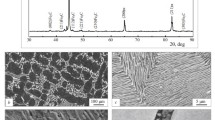Conclusions
-
1.
The strenght of steel 12KhN3A can be increased by secondary hardening without reducing the toughness.
-
2.
Secondary hardening is most effective in steel jointly alloyed with molybdenum and vanadium.
-
3.
The softening preceding secondar,, hardening is due to the decomposition of martensite and the formation of highly dispersed sorbite.
-
4.
Alloyed low-carbon steels that are strengthened by secondary hardening can be classified as sorbite-hardening.
Similar content being viewed by others
Literature cited
V. Zackay et al., Metal Progress,80, No. 3 (1961).
L. I. Kagan et al., Problems of Metal Science and Physics of Metals, No. 8 [in Russian], Metallurgiya, Moscow (1964).
J. Murray, in: High-Strength Steel [Russian translation] Metallurgiya, Moscow (1964).
Additional information
Translated from Metallovedenie i Termicheskaya Obrabotka Metallov, No. 10, pp. 58–60, October, 1971.
Rights and permissions
About this article
Cite this article
Sokolov, O.G., Malyshevkii, V.A. Hardening of low-carbon improved steel by secondary hardening. Met Sci Heat Treat 13, 864–867 (1971). https://doi.org/10.1007/BF00713826
Issue Date:
DOI: https://doi.org/10.1007/BF00713826




